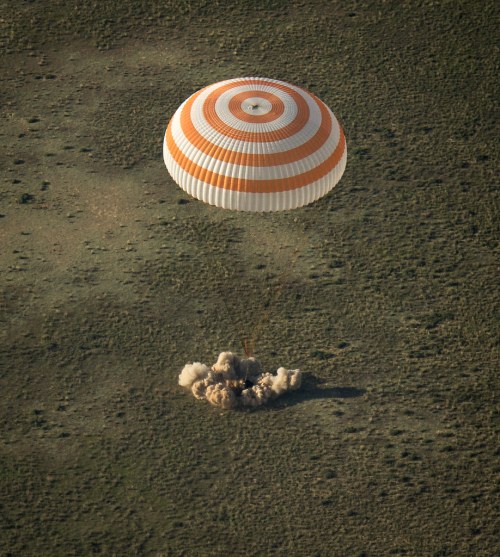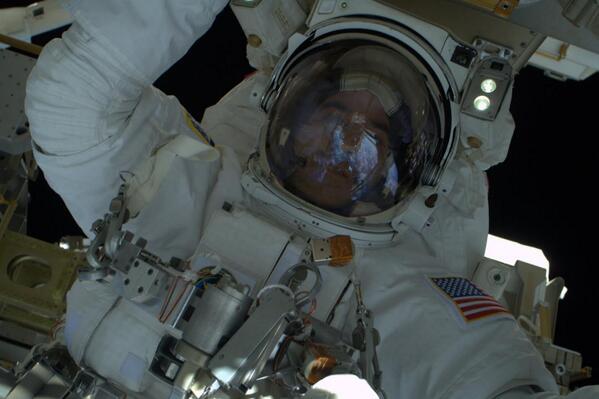
(Photo Credit: NASA/Bill Ingalls)
After living on the International Space Station for 188 days, astronauts Koichi Wakata, Rick Mastracchio and Mikhail Tyurin returned to Earth on May 14th.
Following farewells from their crewmates, Wakata, Mastracchio and Tyurin boarded their Soyuz TMA-11M spacecraft and the hatches between the Station and the vehicle were closed at 7:26pm GMT on 13th May. At 10:36pm GMT, as the station flew 261 statute miles over Mongolia, the Expedition 39 crew undocked and officially departed from the station.
After moving to a safe distance, the Soyuz performed a 4-minute, 41-second burn which slowed the craft for its deorbit descent into Earth’s atmosphere and its parachute-assisted landing. Three and a half hours later, the crew safely landed in Kazakhstan (7:58 a.m. Wednesday 14th, Kazakh time)
 (The Soyuz craft carrying Wakata, Mastracchio and Tyurin departs the ISS – Photo credit: NASA TV)
(The Soyuz craft carrying Wakata, Mastracchio and Tyurin departs the ISS – Photo credit: NASA TV)
Russian recovery teams and NASA personnel reached the landing site in helicopters and all-terrain vehicles just minutes after touchdown. The crew on the ground slowly extracted the astronauts from their spacecraft, and once removed, Wakata, Mastracchio and Tyurin were able to speak to their loved ones on satellite telephones while teams began medical examinations.
 (The crew relax after landing – Photo credit: NASA TV)
(The crew relax after landing – Photo credit: NASA TV)
The Expedition 39 crew spent over 6 months in space, travelling 79 million miles and completing more than 3,000 orbits of the Earth since they launched to the International Space Station back in November 2013. The crew’s arrival at the ISS was particularly distinctive as the astronauts brought the torch used to light the Olympic flame for the 2014 Winter Games to the station. The Olympic torch has been carried into space twice before – in 1996 and 2000 – but it had never left a spacecraft until Expedition 39 as two Russian cosmonauts were able to take the torch on a historic first spacewalk.
As a member of the Japan Aerospace Exploration Agency, Koichi Wakata became the first ever Japanese Commander of the International Space Station as he served as Commander for 66 days during Expedition 39. Wakata has extensive spaceflight experience as he has flown to the station on three Space Shuttle missions; however this was the first time he launched and departed the ISS using the Russian Soyuz spacecraft.
Roscosmos Soyuz Commander Mikhail Tyurin is a spaceflight veteran as he served as a backup crew member for the first ever International Space Station mission, however he also flew on two other expeditions in 2001 and 2006. He has now completed three long duration expeditions at the International Space Station.
Like Wakata, NASA Flight Engineer Rick Mastracchio has flown on three Space Shuttle Missions as a Mission Specialist, but this was his first long duration stay in space. His previous missions only visited the International Space Station for 12-15 days at a time. With Expedition 39 over, the crew have a spent a combined total of over 1000 days in space. During his NASA career, Mastracchio logged a total of 228 days in space, Wakata has accumulated 348 days while Tyurin is now 13th on the all-time endurance list as he has now spent 532 days in space.
 (The Soyuz TMA-11M spacecraft shortly after landing – Photo credit: NASA/Bill Ingalls)
(The Soyuz TMA-11M spacecraft shortly after landing – Photo credit: NASA/Bill Ingalls)
Mastracchio was required to perform 3 unscheduled spacewalks (otherwise called EVA’s) over the 6 month period due to a number of emergencies. The first two EVA’s occurred during the Christmas period in December 2013. Rick and Mike Hopkins, a fellow American crewmate, had to spend a combined time of 13 hours replacing a faulty cooling pump.
The third EVA was performed in April 2014 when Mastracchio, along with NASA astronaut Steve Swanson, removed and replaced a backup computer relay box which had stopped providing power. Although these spacewalks were emergencies and they were totally unplanned, they have made Mastracchio the fifth most experienced spacewalker in the world as he has now a combined EVA time of 53 hours and four minutes.
 (Rick Mastracchio’s ‘selfie’ while on an EVA – Photo credit: Rick Mastracchio/NASA)
(Rick Mastracchio’s ‘selfie’ while on an EVA – Photo credit: Rick Mastracchio/NASA)
The lack of gravity (known as microgravity) on the International Space Station provides scientists with a unique opportunity as the crew can participate in experiments which could not be tested on Earth. Therefore the Expedition 39 crew part took in a wide selection of scientific research tasks including the human immune system activation and suppression study.
The crew also installed a new plant growing chamber inside the ISS which, in the future, will enable astronauts to produce fresh food while in-orbit. They also observed the growth of protein crystals and examined the proteins responsible for causing neurodegenerative conditions.
The return of Wakata, Mastracchio and Tyurin back on Earth notes the conclusion of Expedition 39, however it signals the beginning of Expedition 40. Before departing, Wakata passed control of the station to NASA astronaut Steve Swanson during a change of command ceremony on May 12th.
Swanson will now serve as commander, and he along with his crewmates, Roscosmos Flight Engineers Alexander Skvortsov and Oleg Artemyev of the Russian Federal Space Agency, will operate the station as a skeleton crew until three new crew members arrive.
Reid Wiseman of NASA, Max Suraev of Roscosmos and Alexander Gerst of the European Space Agency will launch to the International Space Station from Baikonur Cosmodrome in Kazakhstan on May 28th. With just over a week until launch, the trio of flight engineers have already wrapped up their pre-flight activities in Star City, Russia and have now flown to Baikonur Cosmodrome to begin final flight preparations.
 (Expedition 40 arrives at the launch site – Photo credit: NASA/Victor Zelentsov)
(Expedition 40 arrives at the launch site – Photo credit: NASA/Victor Zelentsov)
After their medical examinations, Wakata, Mastracchio and Tyurin were welcomed back to Earth with a traditional ceremony held at the Karaganda airport in Kazakhstan. The astronauts were gifted with customary clothing, instruments and individual Russian wooden dolls which depicted each crew member.

(The crew receiving their welcome gifts – Photo credit: NASA/Youtube)
Now that the mission is over, Mikhail Tyurin has travelled to his home in Star City, Russia while Rick Mastracchio and Koichi Wakata have returned to America. The duo boarded a NASA plane which took them to the Johnson Space Centre in Houston for post-flight debriefings, more medical tests and extensive physical rehabilitation to help the astronauts readapt after 6 months of weightlessness at the International Space Station.
All fans of space-flight will remember Koichi, Rick and Mikhail forever!! What a team of Heroes!!